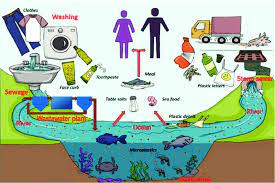
Microplastics pollution poses a significant threat to aquatic ecosystems globally, originating from various sources such as plastic debris breakdown and microbeads. This study investigates the ecotoxicological impacts of these pollutants on marine plants and evaluates mitigation strategies. Field surveys assess their distribution, sources, and fate in rivers, lakes, estuaries, and coastal waters. Sampling methods include sediment cores, water samples, and biological specimens to quantify abundance, size distribution, polymer types, and spatial variability. Source apportionment techniques aid in identifying major contributors to pollution. Laboratory experiments simulate environmental conditions to study their behavior, including sedimentation, resuspension, aggregation, and bioaccumulation. Mathematical models predict dispersal and deposition patterns over varying time scales. Ecotoxicological studies investigate impacts on organisms across trophic levels, including fish, invertebrates, and phytoplankton, considering acute and chronic effects. Mitigation strategies like filtration systems, policy interventions, and public awareness campaigns are evaluated for efficacy in reducing pollution and safeguarding ecosystems. This research contributes to developing sustainable solutions essential for environmental preservation and human health.
Total file downloads: 43